Introduction
This document describes the working of out-of-band dual-tone
multifrequency (DTMF) on the Cisco PGW 2200 for Call Control mode by using
either a Session Initiation Protocol (SIP) Proxy Server, a Cisco H.323
Signaling Interface (HSI) adjunct platform, or both for H.323 communication.
For SIP the sip-notify is a new DTMF relay method that is
proposed on Cisco IOS® Software and on the Cisco PGW 2200. For the Cisco HSI
transmit and receive of H.245 Alphanumeric information during the H.245
negotiation phase is implemented.
Prerequisites
Requirements
Readers of this document should have knowledge of these topics:
Components Used
The information in this document is based on these software and
hardware versions:
Note: Both running on the latest patch level available on
Cisco.com.
The information in this document was created from the devices in a
specific lab environment. All of the devices used in this document started with
a cleared (default) configuration. If your network is live, make sure that you
understand the potential impact of any command.
Conventions
For more information on document conventions, refer to the
Cisco Technical Tips
Conventions.
Cisco PGW 2200 and HSI - DTMF Out-of-band
The Cisco PGW 2200 supports DTMF relay for both SIP and H.323.
H.323
The Cisco PGW 2200 and HSI support out-of-band DTMF relay. DTMF digits
from the media gateway (MGW) are sent to the Cisco PGW 2200 through Media
Gateway Control Protocol (MGCP), and send over via Extended-ISDN User Part
(E-ISUP) messages to the Cisco HSI. This results in a H.245 message from the
Cisco HSI towards a gatekeeper.
Figure 1 - DTMF H.323
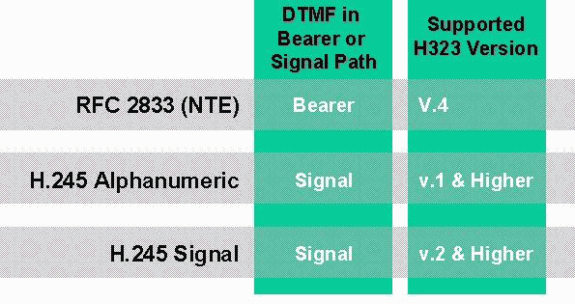
In Figure 1, the Cisco HSI always transmits as type H.245 ''signal."
Basically, the Cisco HSI can receive it as either type H.245 "signal" or
"alpha."
Figure 2 - DTMF MGCP
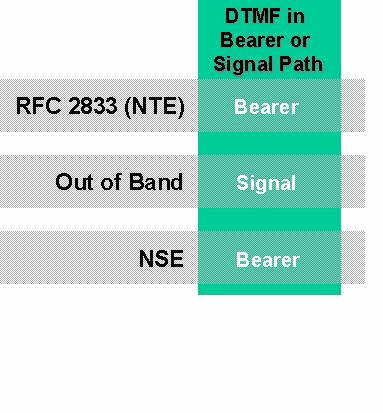
For MGW to Cisco PGW 2200 through the debug mgcp
packet command on the MGW, this information is seen:
From debug mgcp packet output
MGCP...... -> NTFY 123 s0/ds1-1/17@mgw04 MGCP 0.1
X: 703
O: D/0 <--------------------------------received 0
MGCP...... -> 200 123 OK
The H.245 message from Cisco HSI to the gateway through the
debug h245 asn1 command on the gateway tells you
details via the H.245 userInput : signal.
From debug h245 asn1 debug output
00:52:17: H245 MSC INCOMING PDU ::=
value MultimediaSystemControlMessage ::= indication : userInput : signal :
{
signalType "5"
!--- Digit relayed is 5.
Figure 3 - Cisco PGW 2200 and HSI Concept
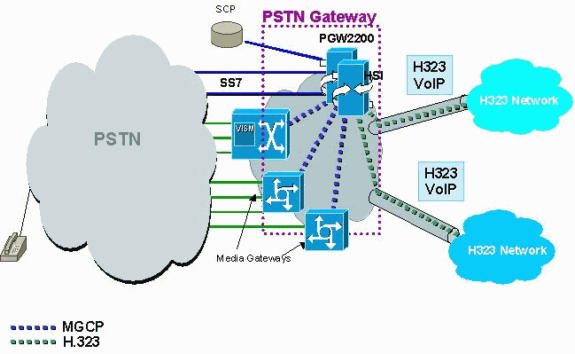
Configuration
On the MGCP gateway, add these commands:
mgcp package-capability dtmf-package
mgcp dtmf-relay voip codec all mode out-of-band
On the Cisco PGW 2200:
Auto-detects
On the Cisco IOS H.323 gateway, under the dial-peer voice
xx voip command, add this command:
dtmf-relay h245-signal
On the Cisco HSI : (HSI provisioning
URL)
prov-add:name=sys_config_static, dtmfsupporteddirection=both
prov-add:name=sys_config_static, dtmfsupportedtype=dtmf
Example
To configure this on the Cisco HSI:
gw mml> prov-sta::srcver="active",dstver="DTMF_Config"
H323 Signalling Gateway Mon Feb 2 13:27:57 2004
M SUCC
Successfully started provisioning session "DTMF_Config" from
"active."
Note: This provisioning session has not been verified.
gw mml> prov-add:name="SYS_CONFIG_STATIC",DtmfSupportedType="dtmf"
H323 Signalling Gateway Mon Feb 2 13:29:18 2004
M SUCC
Successfully added provisioning elements:
gw mml> prov-add:name="SYS_CONFIG_STATIC",DtmfSupportedDirection="both"
H323 Signalling Gateway Mon Feb 2 13:29:41 2004
M SUCC
Successfully added provisioning elements:
gw mml> prov-cpy
H323 Signalling Gateway Mon Feb 2 13:29:49 2004
M SUCC
Note: The HSI needs to be restarted after changing these parameters because
they are "static" and therefore only read during a restart.
MGCP DTMF digits can come out of order, due to the MGCP dual Ethernet
connection.
-
On the sending side, the Cisco IOS AS5xxx detects the digit with a
MGCP NTFY with O: D/1 (MGCP notify with observed event digit
1).
-
On the receiving side, the Cisco IOS AS5xxx sends the digits with a
MGCP RQNT with S: D/1 (MGCP request event while sending the signal digit
1).
In looking for an HSI solution, review the H.245 message which can not
come out of order due to the TCP that keeps the message in sequence. This is
the same for the E-ISUP links using UDP/RUDP (Reliable UDP). During
troubleshooting for such an event, consider the MGCP connection which uses UDP
and can result in the digits being duplicated along the path for packet
re-transmissions. Also, overload of the Ethernet segment can be another reason
for this situation.
SIP
The Cisco PGW 2200 supports out-of-band SIP DTMF from Release 9.4(1)
latest patches. When the Cisco PGW 2200 receives a SIP SUBSCRIBE for DTMF, it
will inform the MGCP gateway to pass the DTMF up to the Cisco PGW 2200, and
then the Cisco PGW 2200 will send a SIP NOTIFY message with the DTMF. From the
other direction, if the Cisco PGW 2200 receives an unsolicited SIP NOTIFY
message with DTMF, the Cisco PGW 2200 will use MGCP to request the MGW to
generate DTMF.
Figure 4 - PGW2200 - SIP
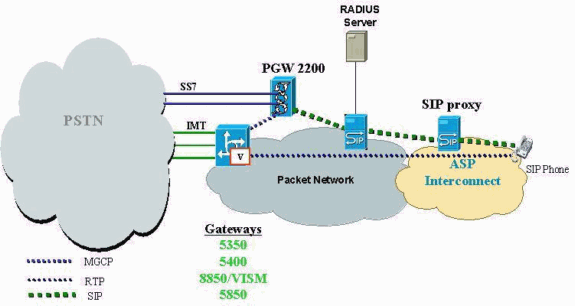
Whether it be solicited or unsolicited, the Endpoint should request
NOTIFICATION via a SUBSCRIBE which will cause the Cisco PGW 2200 to send RQNT
to the gateway and a NOTIFY when the digits are received. Cisco PGW 2200 will
send RQNT to the gateway only after receiving either a SUBSCRIBE message or an
unsolicited NOTIFY response message in 18x/200 message.
Figure 5 - DTMF SIP
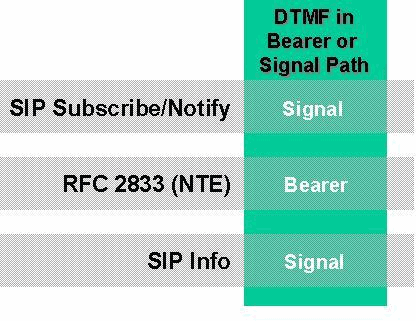
SUBSCRIBE is required if the other SIP side wants to know about DTMF
digits coming from the PSTN. If the Cisco PGW 2200 gets SUBSCRIBE, it will
request the MGCP gateway to pass DTMF events up MGCP, and the Cisco PGW 2200
will send NOTIFY.
If the Cisco PGW 2200 gets an unsolicited NOTIFY from the SIP side, the
Cisco PGW 2200 will request the MGCP gateway to play DTMF towards the
PSTN.
Related Information





 Feedback
Feedback